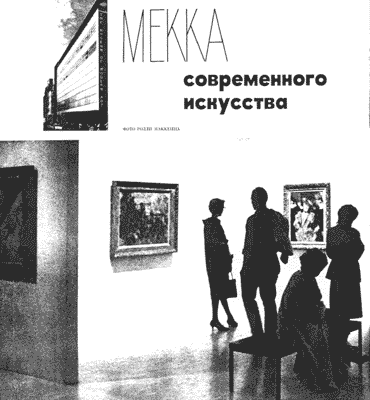|

ref:2004/1
(1)
Juvenile
delinquency and art in Amerika
Mike
O'Mahony
Department of the History of Art, University of Bristol
43
Woodland Road, Bristol BS8 1UU, England
Mike.OMahony@bristol.ac.uk
Keywords:
Cold War culture; USIA (United States Information Agency);
dissidence; stiliagi; Abstract Expressionism.

Abstract
The
period between 1956 and 1962 was undoubtedly one of the most
intense of the early Cold War era. It was also during this
time that both the United States and the Soviet Union most
explicitly deployed and exploited cultural activity as a key
component in the Cold War battle for hearts and minds. It
has often been assumed that, with the exception of isolated
events such as the staging of the American National Exhibition
in Moscow in 1959, the United States had little opportunity
to promote its cultural policies directly and legitimately
within the Soviet Union itself. However, little attention
has so far been paid to the Russian language journal Amerika,
produced in the United States under the auspices of the USIA
and distributed in Moscow to a Soviet readership. This article
examines the ways in which coverage of the visual arts in
Amerika contributed to the promotion of American cultural
values within the Soviet Union. It identifies several key
factors relating to this coverage including: the plurality
of artistic styles promoted; the specific emphasis upon artist
immigrants to the United States; the promotion of experimentalism
and rebellion as core values for all artists; and the strategy
aimed at encouraging Soviet youth to adopt Western cultural
practices at precisely the time when faith in the older generation
was potentially and politically at its most vulnerable in
the Soviet Union.


ref: 2004/1 (2)
Putting
the magic back into design: from object fetishism to product
semantics and beyond
Rafael
Cardoso
Pontifícia Universidade Católica, Rio de Janeiro,
Brazil
rafaelcd@dsg.puc-rio.br
Keywords:
Object fetishism; product semantics; product life cycle; design
theory; material culture.
Abstract
The
present article examines some aspects of the relationship
between form and meaning in artefacts. Exactly how do objects
of art and design express ideas through their appearance,
shape and use? The category of object fetishism is defined
and analysed as a key to understanding such processes of signification.
This category is subsequently applied to existing debates
on product semantics, suggesting that many usual assumptions
about form and meaning need to be re-examined in light of
new conceptions of product life cycle and post-use.


ref:
2004/1 (5)
Peeling
off the skin: Antony Gormley's Inside Australia
Simon
Pierse
University of Aberystwyth, Wales
srp@aber.ac.uk
Keywords:
Antony Gormley; Australia; Perth Festival; Contemporary British
sculpture; Insiders; site-specific art

Abstract
In
2003 the Perth International Arts Festival celebrated its
50th anniversary with a commission given to renowned British
artist Antony Gormley (1950 -). Gormley's Inside Australia
is an installation of 51 stainless steel figures situated
on Lake Ballard, a dry salt lake in a remote region of Western
Australia. His initial attraction to the project was the geology
and geography of Australia's interior but when he discovered
the small community of Menzies, Gormley's ideas evolved towards
an exploration of two separate concepts of interior space:
one within us, the other embodied in the land. Using computer
technology, Gormley made digital scans of most of the inhabitants
of Menzies, reduced their lateral dimensions by two thirds
and made statues based on these measurements in cast stainless
steel. In the 'chemical' landscape of Lake Ballard, the Insiders
resonate with the landscape and suggest a number of associations
with indigenous art, community and culture. They promote a
spiritual interaction with the landscape of interior Australia
and in Gormley's words are 'an excuse for coming here and
thinking about this place and the people who dwell in it'.
A year later, Inside Australia remains in situ and there are
plans to make it permanent. It promises to be another destination
in the outback offering the tourist a spiritual pilgrimage
into Australia's interior.


|


